Results for “”


In today’s day and age, the most successful B2B marketing and sales strategies center on personalization.
Catering to clients’ needs and concerns and ultimately helping to establish a fruitful relationship with prospects that encourages repeat purchasing is a winning formula.
Until recently, in a continued effort to stand out from a crowded market, strategies have mainly been focused on personalization by utilizing buyer personas informed by segmentation strategies such as demographics and firmographics.
However, tailoring campaigns successfully in the current landscape requires detailed knowledge. Data is king and investing in market research tactics to help identify the right data for target segments allows marketers to ultimately create campaigns that prospective clients can better relate to.
B2B psychographics offers marketers a particular kind of insight into prospective clients, by helping them build a more detailed buyer profile based on qualitative data that indicates behavioral and emotional triggers.
The principles of psychographics are based on IAO variables (interests, activities, and opinions) and serve to help marketers connect with their prospects on a cognitive level.
Continued insights from this data tactic help marketers understand past behavior and predict how prospects with similar psychographic characteristics are likely to act in the future. From this, predictive pillars can be established to guide and streamline the acquisition of Marketing Qualified Leads (MQL) and the personalization of sales processes.
As a result, companies are better able to guide potential clients through the consumer journey to generate more leads and sales.
As B2B marketers, you need to understand the behavior, the emotions, and the motivations that drive your customers to purchase products. This is where psychographics comes into play.
Here, we explain how psychographics can be used to attract the right leads and provide them with valuable solutions at the perfect time.
Psychographic data is essential to increasing the success of marketing campaigns and can help to minimize wasted resources. Psychographics is particularly useful in the B2B landscape for establishing personal relationships with prospects and for implementing better nurturing strategies over the longer and more complex purchase periods typical of B2B.
One psychographics example that illustrates the need for psychographics and its many applications is an examination of the process for hiring new employees. Throughout the interview process, employers leverage psychographic data to determine a candidate’s fit based not only on their experience but also their interests and personality.
For example, it is in a company’s interest to hire a project manager who enjoys organization in all aspects of their life. Or a marketing executive who is inspired by the changing trends they read about in their free time.
If applied correctly, psychographics can help to ensure each new employee is the one best suited to their new role.
Below are three further psychographic examples of employee profiles and their contrasting psychographic characteristics that determine them suitable for different roles.
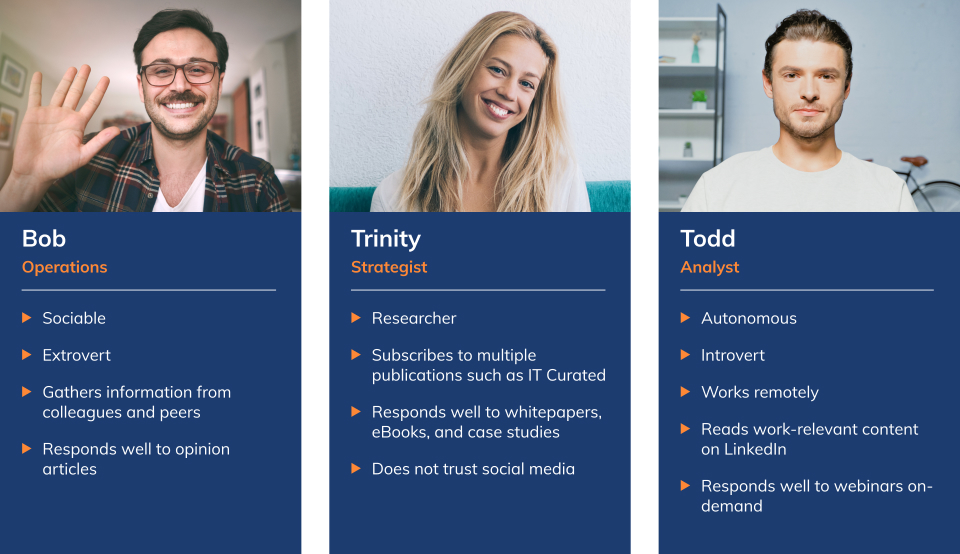



| Bob Operations | Trinity Strategist | Todd Analyst |
|---|---|---|
|
|
|
The complexities of the inner workings of a company’s hiring process are one example of the importance of B2B psychographic segmentation and data.
In much the same way that companies can leverage psychographic information to ensure that each member of their team is a good fit, B2B marketers can also utilize this data to better understand target audiences.
This knowledge can also serve as insights for deciding how to showcase product features and their value to target segments, as the complex nature of B2B products can often make them harder to market than B2C products.
Building a solid database about prospective clients helps to identify the correct channels of communication, how prospects like to work, and therefore, how best to approach them at the right time and frequency.
Traditional segmentation methodologies, as shown below, focus on dividing prospects into segments with shared characteristics based on insights from a variety of data and sources.




| Demographics | Geographics | Behavioral | Firmographics |
|---|---|---|---|
| Age | Local | Benefits | Industry |
| Gender | National | Usage Rates | Location |
| Income | International | Patterns | Size |
| Marital Status | Regional | Status | |
| Ethnic Background | Structure | ||
| Performance |
Segmentation of this nature is used to drive positive interactions by accurately determining target groups and how best to personalize content for them and their buying committees. Effective B2B segmentation, therefore, relies on a vast amount of information and its reliable interpretation.
For most marketers, demographics is the starting point for identifying key segments within a target market and building a strategy to suit them. Demographic data concentrates mostly on:
While demographics can be revealing and integral to the prospect filtering process, data often remains static and as such fails as an indicator of changing buyer intent and needs.
Although prospects may share similar demographics, on a deeper level they are likely to have completely different personalities, business aspirations, and intent characteristics, and as a result, may respond differently to marketing campaigns.
Each prospect will be swayed by several different factors outside their demographic that will influence their buying habits, preferences, and consequently, buyer committees within organizations. These habits will also be open to outside influence and change over time as prospects and the companies they belong to face new challenges that drive the need for new solutions.




| Prospect 1 | Vs. | Prospect 2 |
|---|---|---|
Demographics:
| Demographics:
| |
Psychographic information:
| Psychographic information:
| |
Buyer needs:
| Buyer needs:
|
As this demographics vs psychographics example of two different prospects illustrates, each type of data focuses on entirely different variables. Working purely with demographic segmentation could result in ineffectual marketing and poor ROI.
To effectively market products and services, marketers need to approach their target people on a far more granular level to determine what products they are open to or looking for. This is the strengths of psychographics vs demographics and where they become instrumental to ensuring a successful B2B targeted marketing campaign.
Just like behavioral sciences, B2B psychographics serve to determine key influences on purchase behavior and habits based on cognitive factors.
By approaching buyer intent as a fluid concept, psychographics dives deeper into the persona of a consumer by analyzing a multitude of variables. These include:
The needs of clients continue to develop as they do, resulting in a competitive market of businesses fighting to match their services and solutions. As a result, any metrics which can help give companies the edge over rivals should be taken advantage of and integrated into future strategies.
The aim of psychographics is not to replace demographics or other metrics, but to instead expand upon data from these sources, together with pre-established buyer personas, by providing more detail from psychographic variables.
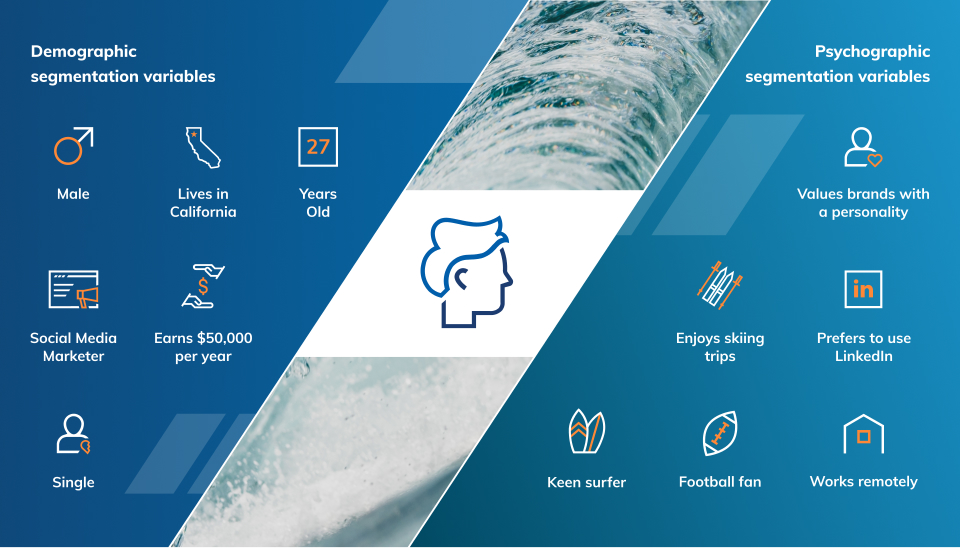
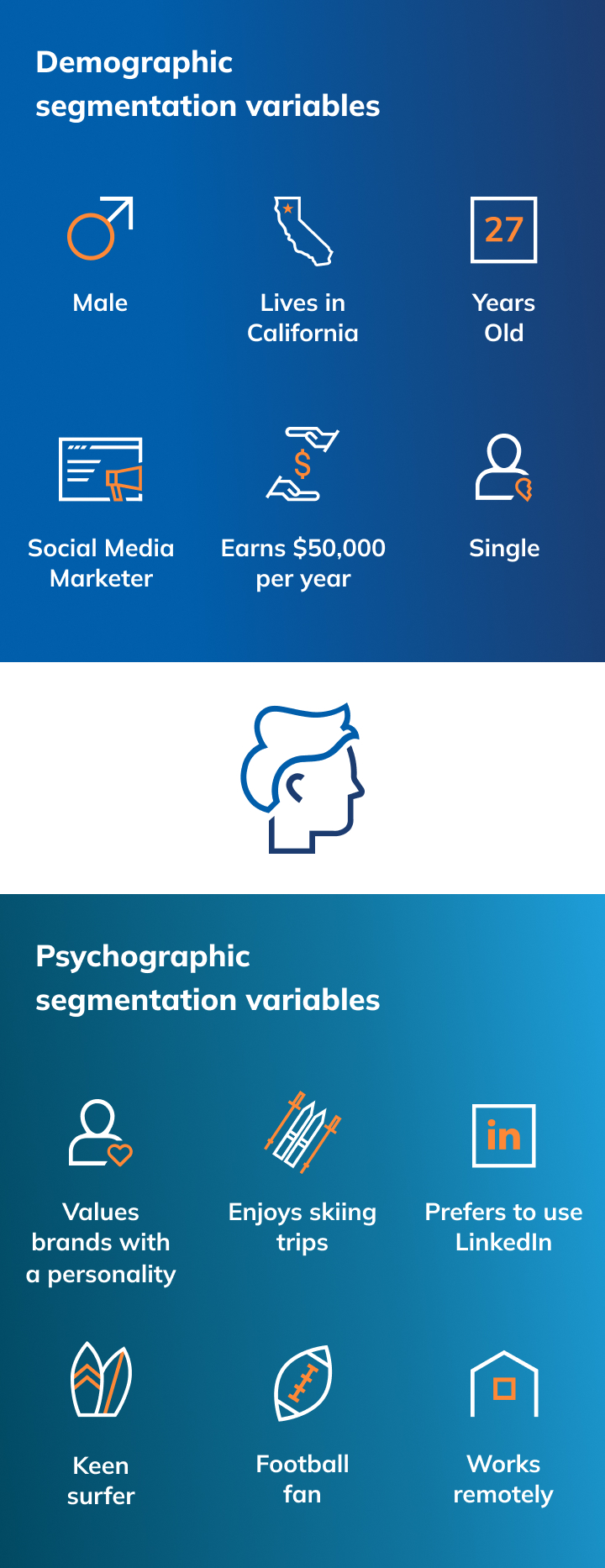


| Demographic segmentation variables | Psychographic segmentation variables |
|---|---|
| Male | Prefers to use LinkedIn |
| Lives in California | Values brands with a personality |
| 27 years old | Football fan |
| Social Media Marketer | Keen surfer |
| Earns $50,000 per year | Works remotely |
| Single | Enjoys skiing trips |
When viewed side by side, it is immediately apparent how indicative psychographic segmentation examples are of buyer personality, motivations, and habits, as well as preferred channels. This data is essential for guaranteeing the high levels of personalization that prospective clients are looking for in a campaign.
Therefore, a successful targeted marketing campaign should make leads feel understood and supported in their work. To ensure this, both marketing and sales teams can inform their messaging to buyer committee members based on psychographic information to better facilitate engagement with prospective clients, nurturing business relationships that endure over time.
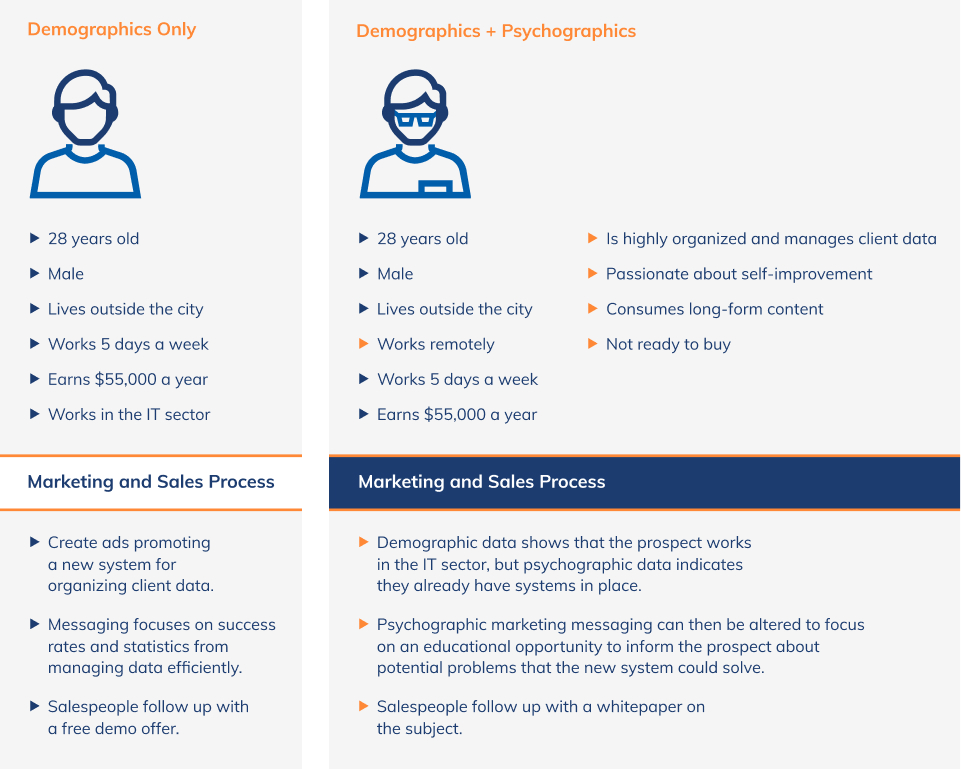



| Demographics Only | Demographics + Psychographics |
|---|---|
|
|
| Marketing and Sales Process | Marketing and Sales Process |
Create ads promoting a new system for organizing client data. Messaging focuses on success rates and statistics from managing data efficiently. Salespeople follow up with a free demo offer. | Demographic data shows that the prospect works in the IT sector, but psychographic data indicates they already have systems in place. Psychographic marketing messaging can then be altered to focus on an educational opportunity to inform the prospect about potential problems that the new system could solve. Salespeople follow up with a whitepaper on the subject. |
Through the addition of the psychographic profile messaging can be made more effective. This is because marketers can begin relating to prospective clients on a personal level that demonstrates a genuine understanding of their needs and target goals.
The best leads are bombarded by choices and personalized content across multiple channels every day. As such, for content and messaging to be truly effective in its mission to appeal to a target audience, it needs to be relevant, engaging, and indicative of the dedicated service a company can provide.
In essence, psychographic data focuses on the part of the individual not able to be defined by demographic or firmographic information. This includes their values, interests, pain points, and opinions specific to them.
There are several methods and channels for collecting this data. But to get the most out of B2B psychographic research, it is best to employ multiple methods to help develop the clearest indicators and better inform decision making.
In addition to recording sales team interactions, an effective way to gather psychographics is by interviewing both existing and potential clients.
This is a good place to start as honest feedback and a fresh perspective are often more insightful than raw statistics. It is also demonstrative of how much a business cares about its clientele and values what they think.
Interviews allow B2B marketers to assess campaigns and outreach while ongoing. Useful questions to ask include:
These questions can also be formulated into surveys and questionnaires to cover a wide client base at a low cost. However, interviews are often more effective in developing genuine insights due to the greater scope for nuance and their more personal nature.
Analyzing multiple social media platforms is another effective way of collecting psychographic information. Beyond connecting groups of people with others around the world, social media gives users a place to express preferences with curated audiences and start discussions.
Each target audience will use social media platforms in different ways and for different purposes, for example, to learn about trends, or to promote their own brand. Analyzing how and why leads use specific platforms can be insightful and help make marketing efforts more relevant.
Many users use social media for social proofing, that is, relating their personal experiences to others. Both in a positive way, through recommendations, and in negative ways, through the posting of grievances or other issues. Prospect interactions and networking with other B2B users can also be indicative of how they value social media as a channel.
With the right care, social media can be utilized as an influential learning tool for determining specific audience psychographics. This can be leveraged to and inform how companies should present themselves and build psychographic marketing campaigns.
Website analytics, such as interactions with site content and where visitors come from, can be integral to understanding a target market.
Raw data from the Google Analytics dashboard can not only be used to identify successful content and areas that require further improvements but also to provide psychographic information. Website statistics can be refined and used to determine audience interests, for example.
Through effectively filtering data, B2B marketers can collect psychographic data alongside other findings to guide them in establishing and maintaining web content that is both relevant and attractive.
After determining a segment’s psychographic profile, campaigns should be customized to incorporate the most effective tone or language with which to best communicate with target audiences.
Insightful psychographic information can be collected from studying data from sources such as posts on social media, together with direct interactions with existing or prospective clients.
How and what language is used can reveal industry-specific terminology, states of mind, decision-making processes, business aspirations, and personal opinions to help marketers create relatable campaigns that can establish them as “insiders”.
As such, building a library of different target audience language preferences can be beneficial. This will help to inform various aspects of future psychographic marketing campaigns to increase the chances of their success, from creating accurate buyer personas to linguistic content, design, and imagery.
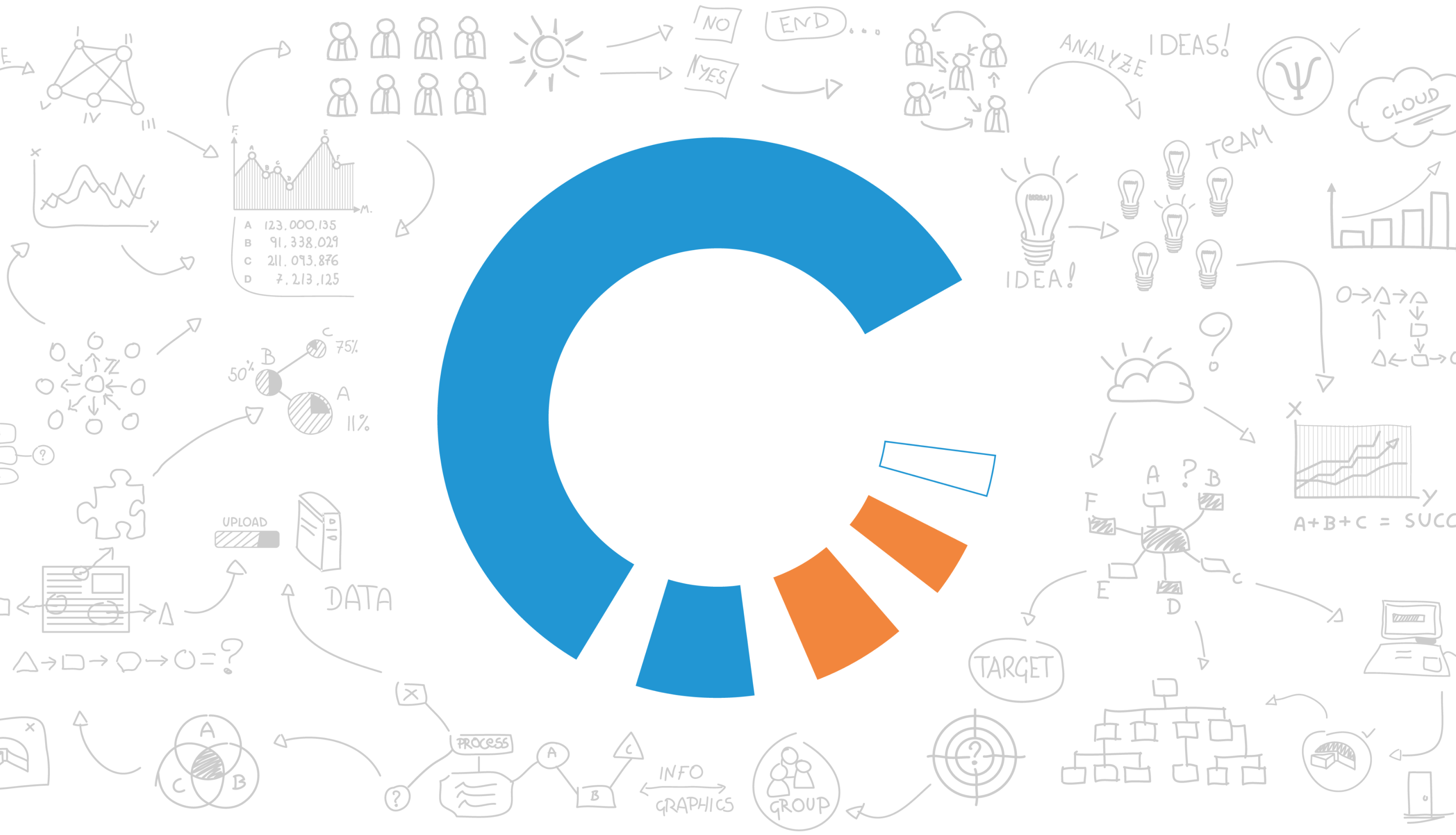
B2B Psychographic data can be leveraged to create detailed predictive pillars and buyer personas that serve to further segment target audiences into specific groups, inform psychographic marketing strategies, and allow for the implementation of micro-targeting.
Due to their artificial nature, buyer personas are only as effective as the data that drives them. Psychographic information provides more detailed insights into buyer behavior, habits, business goals, and decision-making processes than geographic and demographic data alone.




| Persona 1 | Persona 2 | Persona 3 |
|---|---|---|
|
|
|
| Best content/channels (centered across all 3 columns) | ||
|
|
|
Knowledge of these habits ensures that marketers avoid wasting time and resources, or inaccurately segmenting prospective clients. The process of B2B psychographic segmentation with buyer personas requires constant and thorough market research and analysis to ensure that campaigns are fueled with up-to-date information.
The way that target audiences consume and interact with content is never set in stone. Instead, it will continue to evolve and in doing so the channels through which content is delivered will likely change as well.
As each prospective client is unique, their preferred platforms and ways of consuming content will also vary to some extent. Establishing which distribution channels are preferred by different segments is therefore instrumental in ensuring the success of content and sales strategies.
Psychographic information and analysis are particularly effective in helping marketers to prioritize publishing across multiple channels that are appropriate for reaching each target audience and influencing their buying decisions.
By measuring interaction and engagement with content, marketers can also identify the correct frequency of outreach. Data can be analyzed to ascertain the time of day, and the day of the week, that are most conducive to positive engagement. As such, psychographic marketing campaigns are more likely to achieve success.
Programmatic marketing refers to the automatic process of bidding for display advertising spaces.
When a visitor who meets the psychographic target market criteria lands on a page that is set up with programmatic marketing, bidding begins.
These digital auctions are incredibly competitive. Companies establish their maximum bids ahead of time with the highest bidder winning each space within a fraction of a second before the page loads for that user.
Using well-interpreted B2B psychographic data, programmatic marketing is an efficient strategy that compounds the effect of advertising campaigns by ensuring they reach the target audience at the optimal time.
The implementation of psychographics in content creation strategies aids B2B marketers in ensuring that content is accurately personalized for each target segment.
Psychographics can identify relevant content topics that inform, promote engagement, and demonstrate to prospects how they stand to benefit from products and services. This psychographic marketing approach can also be applied to outbound communications and prospective marketing. This includes email blasts, cold call scripts, and the creation of any specialized targeted content.
Content fueled by psychographic information and psychographic segmentation is better able to resonate with potential clients’ real interests, business targets, and values, generating trust and brand loyalty as a by-product.
INFUSE’s team of creatives and content specialists craft content for some of the world’s biggest businesses.
Our team will analyze your strategic needs and develop content marketing assets that deliver results for your demand generation campaigns. There is no limit to the formats and asset types that we can create, including articles, whitepapers, e-books, video, and infographics.
As B2B relationships with clients tend to be lasting and more personal, with longer purchase periods than B2C counterparts, the importance of managing and maintaining these relationships is paramount to generating repeat sales.
Despite the common misconception that B2B decisions are only rational and regardless of whether contacts are clients or not, people are generally hopeful the future will be easier and happier. Psychographic data can be utilized to appeal to the aspirations and ideology of each prospect and segment. Addressing the emotional side of decision-making with psychographics focuses on qualitative attributes that are harder to define via raw data sets.
During prolonged and repeated sales cycles of more complex products and services across a long-term purchase period, appealing to emotions with aspirational imagery and messaging is effective in motivating a B2B buyer group to purchase a product.
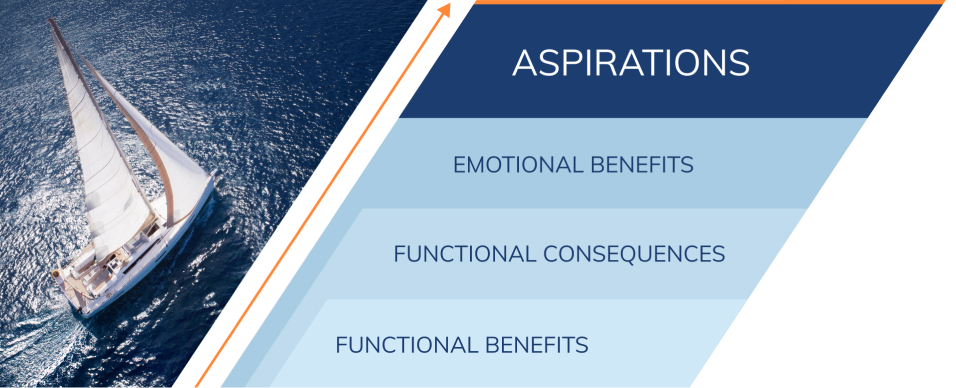
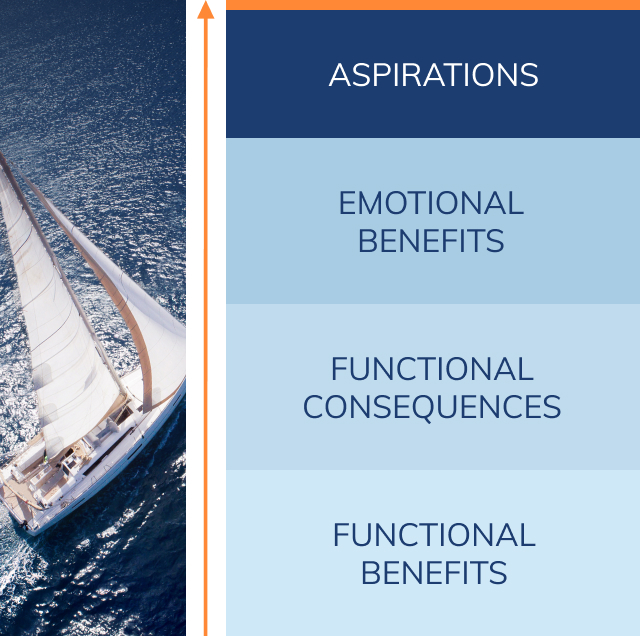


| Aspirations |
|---|
| Emotional benefits |
| Functional consequences |
| Functional benefits |
Information derived via B2B psychographics can aid with the continuous testing and reconfiguration of campaign strategies.
It can be integrated into and inform A/B testing of different theories to appeal to specific buyer personas, ensuring strategies are at their most effective. If deemed unsuccessful, then they can be adapted to meet the changing behavior and needs of prospective clients.
Testing serves as quality control for determining the most effective psychographic marketing strategies that reach out to prospects in an organic manner, balancing personalization but without becoming invasive.
Psychographic characteristics and psychographic market segmentation complement other targeting strategies to generate more MQLs, and better lead generation in general.
Collecting and using psychographic data to develop relevant messaging to cater to the unique profiles of target audiences means your targeted marketing campaigns are more likely to be relevant and encourage purchases as a result.
The better the understanding of target segments, the better marketers can create psychographic marketing with behavioral indexes. This way the past can be learnt from to predict future buyer behavior that can inform the most effective lead generation tactics that relate to decision-makers on a cognitive level.
To provide the best experiences, we use technologies like cookies to store and/or access device information. Consenting to these technologies will allow us to process data such as browsing behavior or unique IDs on this site. Not consenting or withdrawing consent, may adversely affect certain features and functions.